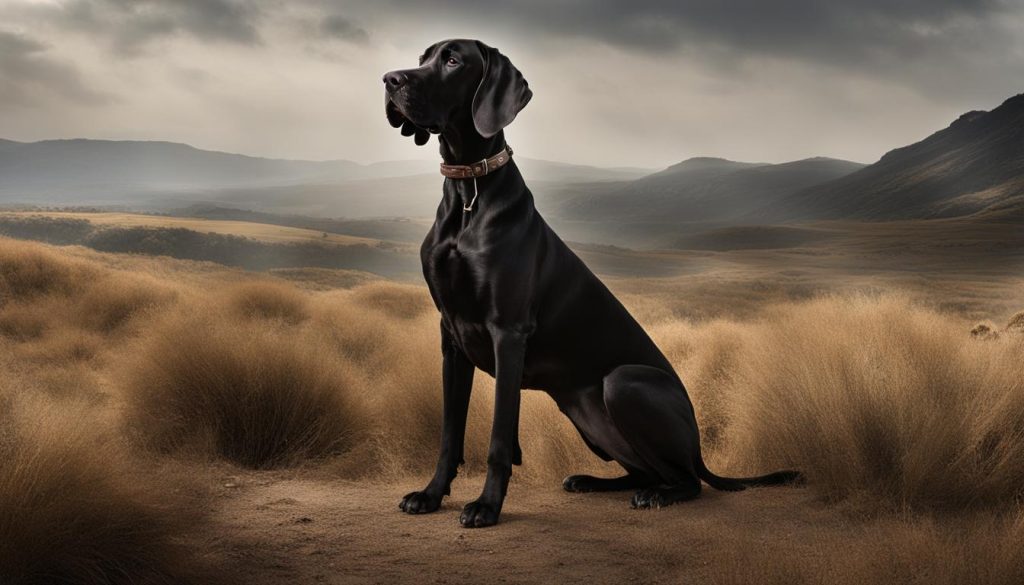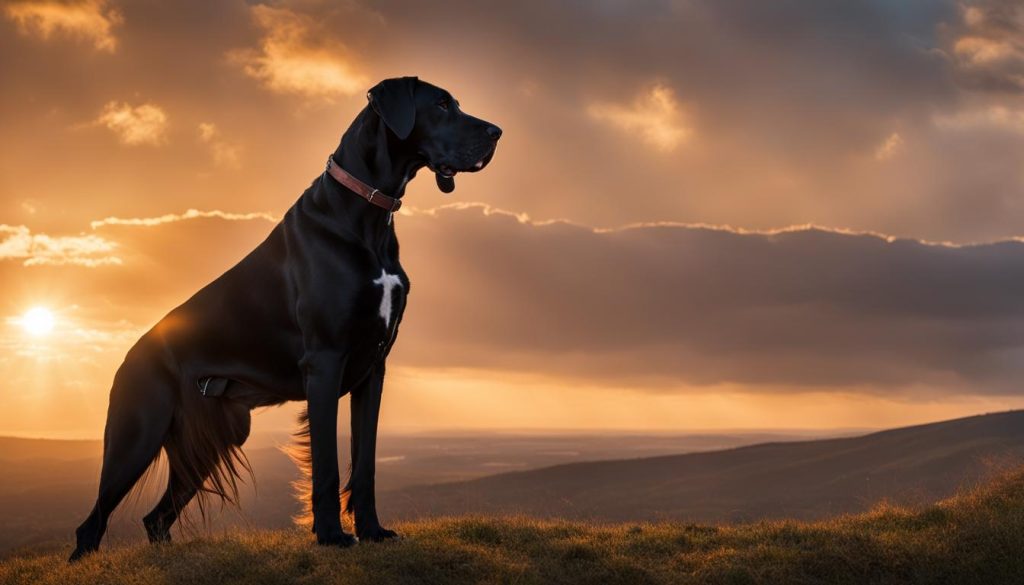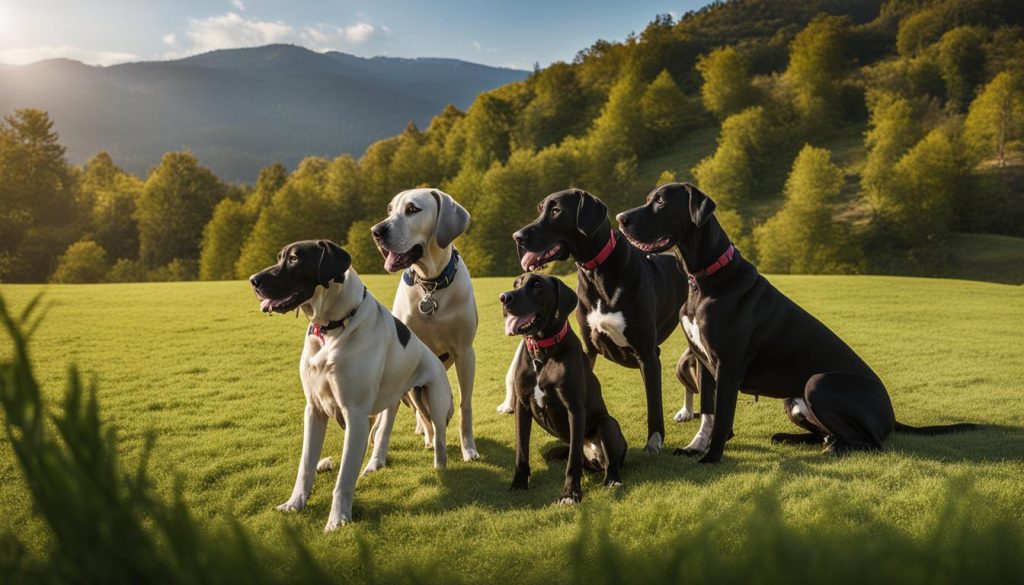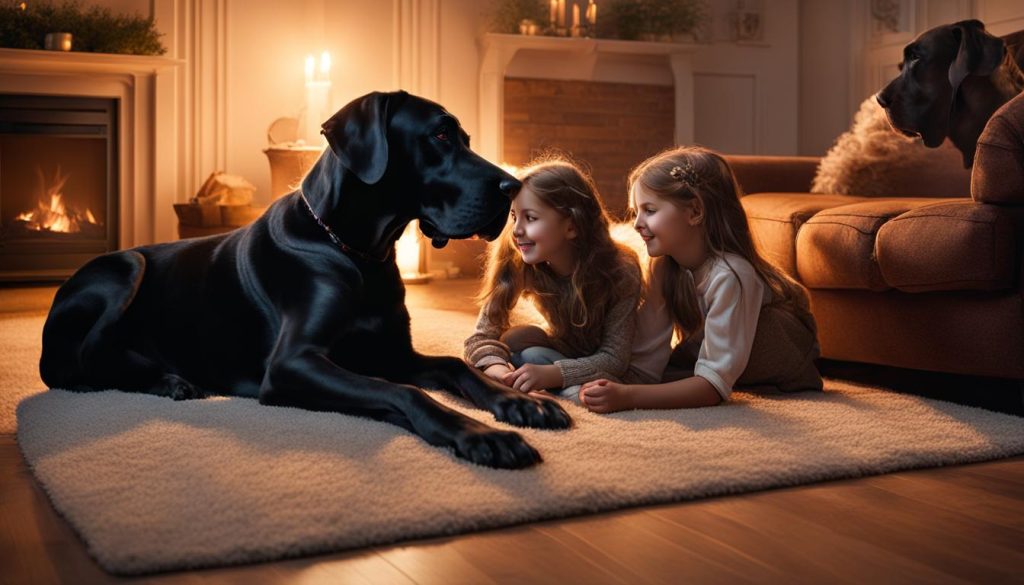Great Danes are majestic and imposing giant breed dogs that have captured the hearts of many dog lovers around the world. Developed in Germany during the 19th century, their exact origins may be debated, but their popularity among dog breeders is undeniable. Despite their size, Great Danes are known for their gentle and affectionate temperament, making them a top choice for families. Responsible ownership includes providing them with a balanced diet, grooming, training, and regular veterinary check-ups.
Key Takeaways:
- Long haired Great Danes are majestic and gentle giants.
- They have a regal appearance and a gentle temperament.
- Grooming, training, and regular veterinary care are essential for their well-being.
- They are a popular choice for families due to their affectionate nature.
- Long haired Great Danes require proper maintenance to keep their coat healthy.
The History of Great Danes
The history of Great Danes can be traced back to 19th-century Germany, where they were bred and developed into the majestic dogs we know today. Their exact origins may be debated, but it is widely accepted that Great Danes were created by crossing English Mastiffs with Irish Wolfhounds. This combination resulted in a breed that possessed the strength and size of the Mastiff and the speed and agility of the Wolfhound. Initially, Great Danes were primarily used for hunting large game, such as boars and deer, due to their impressive size and hunting instincts.
Over time, Great Danes’ role transitioned from being hunters to becoming loyal companions and family dogs. Their gentle and affectionate temperament, combined with their imposing stature, made them highly sought after by dog enthusiasts. The breed’s popularity gradually spread from Germany to other parts of Europe and eventually to the United States. Today, Great Danes are recognized and appreciated worldwide for their regal charm, graceful movements, and loving nature.
Throughout history, Great Danes have also been referred to as “German Mastiffs” due to their German origins and resemblance to the Mastiff breed. This name highlights their heritage and emphasizes their lineage from strong and powerful dogs. As desirable companion animals, Great Danes have captured the hearts of many individuals and families, making them a beloved breed that continues to thrive.

Table: Origins of Great Danes
| Breed | Contributions |
|---|---|
| English Mastiffs | Provided strength and size |
| Irish Wolfhounds | Added speed and agility |
The Majestic Presence and Appearance
Great Danes truly live up to their name, commanding attention wherever they go with their majestic presence and striking appearance. Standing tall with an elegant stature, these dogs have a regal charm that is hard to ignore. With their well-proportioned, muscular bodies, they exude strength and grace in every movement.
One of the defining features of Great Danes is their variety of colors. From sleek black coats to stunning harlequin patterns, their appearance is as diverse as it is captivating. Their large heads are adorned with deep-set, expressive eyes that radiate intelligence and kindness. It is no wonder that these dogs have become iconic symbols of beauty and grace.
Whether they are strutting their stuff in the show ring or simply lounging at home, Great Danes leave an indelible impression with their majestic presence and captivating appearance.

The Majestic Stature of Great Danes
When it comes to size, Great Danes are truly larger than life. These gentle giants stand tall as one of the largest dog breeds in the world. On average, males can reach a height of 30 to 34 inches at the shoulder, while females typically measure slightly smaller at 28 to 32 inches. Their weight can range anywhere from 100 to 200 pounds.
Despite their imposing size, Great Danes are known for their gentle and affectionate nature. They are prized as family dogs due to their calm and patient temperament. Whether they are curled up on the couch or out for a leisurely walk, their elegant stature and regal charm never fail to turn heads.
A Palette of Colors
Great Danes come in a stunning variety of colors, adding to their allure. While the solid black coat is a classic choice, there are many other shades to choose from, including fawn, blue, brindle, and merle. The harlequin pattern, with its striking black and white spots, is particularly eye-catching and unique.
The various colors of Great Danes not only add to their visual appeal but also showcase the diversity within the breed. Each color has its own distinct charm, and dog owners often have their preferences based on personal taste. Whether sleek and black or speckled with spots, Great Danes never fail to make a statement with their coat colors.
| Coat Color | Description |
|---|---|
| Fawn | Light golden brown with black mask |
| Brindle | Striped pattern consisting of fawn and black |
| Blue | Diluted grayish-blue color |
| Merle | Patchy pattern with a mix of colors |
| Harlequin | Large black spots on a white background |
Gentle Giants: Temperament and Personality
Great Danes, often referred to as gentle giants, are beloved for their pretty good temperament and affectionate nature. Despite their impressive size, these dogs are known for their docile and gentle disposition, making them excellent companions and family pets. They possess a strong sense of loyalty and are highly protective of their loved ones, making them reliable guardians.
One of the defining characteristics of Great Danes is their patience and tolerance, especially when it comes to children. They are incredibly gentle and understanding, making them perfect for families with young ones. Great Danes are known to form strong bonds with their human family members and are always eager to please, making them highly trainable.
Proper socialization and training are essential for Great Danes to thrive. Exposing them to various environments, people, and animals from a young age helps them develop confidence and adaptability. Additionally, obedience training is crucial for shaping their behavior and ensuring they become well-behaved and well-mannered dogs. With consistency, positive reinforcement, and firm yet gentle guidance, Great Danes can reach their full potential and become well-rounded members of society.
Tips for Training and Socialization:
- Start training and socialization from a young age
- Use positive reinforcement techniques, such as treats and praise, to encourage desired behavior
- Expose your Great Dane to various environments, people, and animals to promote adaptability
- Provide consistent training sessions to reinforce obedience commands
- Enroll in obedience classes or seek guidance from a professional dog trainer, if needed
“Great Danes are known for their gentle and affectionate nature. With proper training and socialization, they can be wonderful family pets, bringing joy and love to their owners.” – Professional Dog Trainer
You should note that while Great Danes are generally friendly and well-mannered, individual temperaments may vary. Early socialization and training play a significant role in shaping their behavior. Owners should prioritize responsible ownership by providing a loving and nurturing environment, meeting their physical and emotional needs, and ensuring regular veterinary care.
| Traits | Description |
|---|---|
| Loyal and Protective | Great Danes are fiercely loyal and protective of their family members, making them excellent guard dogs. |
| Patient and Tolerant | These gentle giants exhibit a pretty good level of patience and tolerance, especially with children. |
| Affectionate | Great Danes are known for their affectionate nature and form strong bonds with their owners. |
In summary, Great Danes are pretty good dogs known for their gentle and affectionate temperament. They are loyal, protective, patient, and tolerant, making them ideal companions and family pets. With proper training and socialization, these gentle giants can thrive in any loving home, bringing joy and happiness to their owners.
Training and Socialization for a Happy Dane
Training and socialization are essential for the well-being and happiness of Great Danes. Positive reinforcement techniques and early training help establish a strong bond and ensure good behavior. Great Danes are intelligent and eager to please, making them highly trainable. Obedience commands such as sit, stay, and come should be taught from an early age to ensure they understand and follow instructions.
Exposure to different environments, people, and animals is crucial for a well-socialized Great Dane. Introduce them to various situations and stimuli, such as walks in the park, visits to pet-friendly establishments, and interactions with other dogs and people. This helps them become confident and comfortable in different settings, reducing the chances of fear or aggression.
“Proper socialization helps Great Danes develop into well-behaved and calm dogs.”
Consistency is key when training a Great Dane. Regular training sessions should be conducted, focusing on positive reinforcement and rewards for desired behavior. This can include treats, praise, or playtime as a way to motivate and reinforce their good conduct. Avoid harsh or punitive training methods, as they can cause fear or anxiety in these sensitive dogs.
| Training Tips for Great Danes | Socialization Techniques |
|---|---|
|
|
By following these training and socialization techniques, you can raise a well-behaved and happy Great Dane. Try to provide plenty of mental stimulation and exercise to keep them physically and mentally stimulated. With the right guidance and care, your Great Dane will grow into a well-adjusted and lovable companion.

The Best Dogs for Families
Great Danes are widely regarded as one of the best dog breeds for families, and it’s easy to see why. Their gentle and affectionate nature make them perfect companions for both adults and children. Great Danes have a natural patience and tolerance when interacting with kids, making them ideal playmates and protectors.
One of the pretty good qualities of Great Danes is their loyalty and protective instincts. They form strong bonds with their human family members and will go to great lengths to keep them safe. Their imposing size alone is often enough to deter intruders, making them excellent watchdogs.
When it comes to the dynamics of a family, Great Danes seamlessly blend in and become an integral part of the household. They thrive on being part of a loving family and are always ready to offer their unconditional love and support. Whether it’s playing in the backyard, snuggling on the couch, or going for long walks, Great Danes are always excited to join in on the family activities.

Testimonial: A Loving Companion
“Our Great Dane, Max, has been the perfect addition to our family. He is so gentle and patient with our young children, and we couldn’t ask for a better protector. Max truly embodies the qualities of a family dog, and we can’t imagine our lives without him.” – The Johnson Family
When considering a family dog, the gentle and affectionate nature of Great Danes, their patience and tolerance with children, and their loyalty and protection make them an excellent choice. Whether you have a small or large family, Great Danes are sure to bring joy and love to your home.
Harlequin Great Danes: Unique and Majestic
Harlequin Great Danes are a unique variation of the Great Dane breed, known for their stunning coat patterns and gentle demeanor. These magnificent dogs have a distinctive coat pattern featuring black and white spots, creating a striking and eye-catching appearance. The exact origin of Harlequin Great Danes is unknown but is believed to have originated in Germany in the 18th century.
One of the fascinating aspects of Harlequin Great Danes is the variation in eye color. Some Harlequin Danes have brown eyes, while others have blue, green, or even a combination of colors. This diversity adds to their allure and makes each individual dog a truly one-of-a-kind companion.
Beyond their captivating appearance, Harlequin Great Danes are known for their gentle, affectionate nature. They possess a calm and patient temperament, making them loving and loyal family pets. Despite their imposing size, they are often gentle giants who are great with children and other animals.
Whether you are captivated by their unique coat patterns or drawn to their gentle demeanor, Harlequin Great Danes are a breed that embodies both uniqueness and majesty. Consider adding one of these magnificent dogs to your family, and experience the joy and companionship they bring.

Grooming and Care for Harlequin Great Danes
Proper grooming and care are essential for maintaining the health and appearance of Harlequin Great Danes. While their short, smooth coats require minimal grooming compared to other long-haired breeds, there are still important aspects to consider.
Brushing
Regular brushing helps remove loose fur and keeps the coat of Harlequin Great Danes shiny and free from tangles. A soft-bristle brush or a grooming mitt can be used to gently brush their coat, paying attention to areas prone to matting, such as behind the ears and under the armpits.
Bathing
Harlequin Great Danes do not require frequent baths unless they become dirty or develop an odor. Use a mild shampoo specifically formulated for dogs, and be sure to rinse their coat thoroughly to avoid any residue. Bathing too frequently can strip the natural oils from their skin, leading to dryness and potential skin issues.
Nail Care
Regular nail care is important for Harlequin Great Danes to prevent discomfort and potential issues with their gait. Trim their nails carefully using a dog nail clipper or grinder, being cautious not to cut into the quick, which is the sensitive part of the nail. If you are unsure about nail trimming, consult a professional groomer or veterinarian for assistance.
Dental Care
Like all dogs, Harlequin Great Danes require regular dental care to maintain good oral health. Brush their teeth with a dog-specific toothbrush and toothpaste at least two to three times a week to prevent tartar buildup and gum disease. Providing dental chews and toys can also help promote healthy teeth and gums.
Exercise and Nutrition
Regular exercise is important for Harlequin Great Danes to keep them physically and mentally stimulated. Daily walks, play sessions, and supervised off-leash activities in a secure area are recommended. Additionally, ensure they have a balanced diet that meets their nutritional needs. Consult with a veterinarian to determine the appropriate diet and feeding schedule for your Harlequin Great Dane.
Regular Vet Visits
Regular veterinary check-ups are crucial for monitoring the overall health and well-being of Harlequin Great Danes. Schedule routine visits with a trusted veterinarian to ensure vaccinations are up to date, and to address any concerns or health issues that may arise. Early detection and treatment are key to maintaining their optimal health.
In summary, grooming and care for Harlequin Great Danes involve regular brushing, occasional bathing, nail care, dental care, exercise, nutrition, and regular veterinary check-ups. By providing proper grooming and care, you can help your Harlequin Great Dane stay healthy, happy, and looking their best.
| Aspect of Grooming and Care | Frequency |
|---|---|
| Brushing | Regularly, at least once a week |
| Bathing | As needed, when dirty or odorous |
| Nail Care | Regularly, as needed |
| Dental Care | Two to three times a week |
| Exercise | Daily, with walks, play sessions, and off-leash activities |
| Nutrition | As recommended by a veterinarian |
| Veterinary Check-ups | Regularly, as scheduled by a veterinarian |
To put it simply, each Harlequin Great Dane is unique, and their grooming and care requirements may vary. I recommend that you observe your dog’s specific needs and consult with professionals for personalized advice.

Health and Lifespan of Harlequin Great Danes
Harlequin Great Danes, like all large breeds, are prone to certain health issues that potential owners should be aware of. You should provide them with the necessary care and attention to ensure their well-being. Some common health problems that affect Harlequin Great Danes include:
- Hip Dysplasia: This is a condition where the hip joint doesn’t fit properly, leading to discomfort and pain. Regular exercise and maintaining a healthy weight can help minimize the risk of hip dysplasia.
- Bloat: Also known as gastric dilation volvulus, it is a potentially life-threatening condition where the stomach fills with air and twists. Feeding smaller meals throughout the day and avoiding vigorous exercise after meals can help reduce the risk of bloat.
- Heart Disease: Great Danes, including Harlequins, are prone to heart issues such as dilated cardiomyopathy. Regular veterinary check-ups and a heart-healthy diet can help monitor and manage heart disease.
- Eye Problems: Harlequin Great Danes may be susceptible to certain eye conditions, including cataracts and progressive retinal atrophy. Regular eye examinations are important for early detection and treatment.
It is crucial for Harlequin Great Dane owners to be attentive to any signs of health issues and seek veterinary care immediately if necessary. Regular check-ups and preventive measures, such as vaccinations and parasite control, are essential for maintaining their well-being. A well-balanced diet, exercise, and a loving environment can contribute to a longer and healthier lifespan.
Harlequin Great Dane Lifespan
The lifespan of a Harlequin Great Dane typically ranges from 7 to 10 years, which is shorter compared to smaller dog breeds. However, with proper care and attention to their specific health needs, Harlequin Great Danes can still lead fulfilling lives. Regular exercise, a balanced diet, and routine veterinary care can help promote their overall health and increase their lifespan.

| Health Issues in Harlequin Great Danes | Lifespan |
|---|---|
| Hip Dysplasia | 7-10 Years |
| Bloat | |
| Heart Disease | |
| Eye Problems |
Final Thoughts
In conclusion, the long-haired Great Dane is a truly majestic and beautiful breed. These gentle giants have captured the hearts of dog lovers worldwide with their regal presence and affectionate nature. Whether you choose a long-haired Great Dane or any other variation of this pretty good breed, they are sure to bring joy and companionship to your life.
This article has explored the fascinating history and origins of Great Danes, their striking appearance, gentle temperament, and suitability as family dogs. We have discussed the importance of training, socialization, grooming, and regular veterinary care for the well-being of these magnificent creatures.
Whether you are drawn to the elegance of the long-haired Great Dane or the unique coat patterns of the Harlequin variation, responsible ownership is key to ensuring their health and happiness. By providing them with proper care and a loving home, you can enjoy the companionship and loyalty of these majestic creatures for many years to come.
FAQ
What is the history of Great Danes?
Great Danes originated in 19th-century Germany through the crossbreeding of English Mastiffs and Irish Wolfhounds. They were initially used for hunting but later became companions and guardians.
What is the temperament of Great Danes?
Great Danes are known for their gentle and affectionate nature. They form strong bonds with their families, are patient and tolerant with children, and are loyal and protective.
How should I train and socialize my Great Dane?
Training and socialization are important for the well-being of Great Danes. Positive reinforcement techniques and early training help establish a strong bond and ensure good behavior. Socialization involves exposing them to different environments, people, and animals from a young age.
Are Great Danes good family dogs?
Yes, Great Danes are excellent family dogs. They are patient and tolerant with children and are known for their loyalty and protective instincts. Their imposing presence also makes them great watchdogs.
What are Harlequin Great Danes?
Harlequin Great Danes are a unique variation of the breed known for their stunning coat patterns and gentle demeanor. They have black and white spots and come in different eye colors.
How do I groom and care for a Harlequin Great Dane?
Harlequin Great Danes have short, smooth coats that require regular brushing to remove loose fur and keep their coat shiny. They do not need frequent baths but should be bathed with a mild shampoo when necessary. Nail care, dental care, exercise, and a balanced diet are also important.
What are the common health issues in Harlequin Great Danes?
Harlequin Great Danes, like all large breeds, are prone to health issues such as hip dysplasia, bloat, heart disease, and eye problems. Regular veterinary care, preventive measures, and a healthy lifestyle can help manage these issues.






